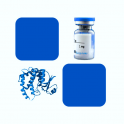
- Remove this product from my favorite's list.
- Add this product to my list of favorites.
Products
Newsletter
 |  |  |  |  |  |

Background
Integrins are transmembrane proteins that mediate interactions between adhesion molecules on adjacent cells and/or the extracellular matrix (ECM). Integrins have diverse roles in several biological processes including cell migration during development and wound healing, cell differentiation, and apoptosis. Their activities can also regulate the metastatic and invasive potential of tumor cells. Integrin alpha 4 beta 1(Alpha-4/beta-1) is receptors for fibronectin. Integrin alpha-4/beta-1 is a receptor for VCAM1 and recognizes the sequence Q-I-D-S in VCAM1.
Source
Recombinant Biotinylated Human ITGA4&ITGB1 Heterodimer Protein, His,Avitag&Tag Free (IT1-H82W1) is expressed from human 293 cells (HEK293). It contains AA Tyr 34 - Thr 977 (ITGA4) & Gln 21 - Asp 728 (ITGB1) (Accession # P13612-1 (ITGA4) & P05556-1 (ITGB1)).
Predicted N-terminus: Tyr 34 & Ser 592 (ITGA4) & Gln 21 (ITGB1)
Molecular Characterization
Biotinylated Human ITGA4&ITGB1 Heterodimer Protein, His,Avitag&Tag Free, produced by co-expression of ITGA4 and ITGB1, has a calculated MW of 113.2 kDa (ITGA4) and 83.7 kDa (ITGB1). Subunit ITGA4 is fused with an acidic tail at the C-terminus and followed by a polyhistidine tag and an Avi tag (Avitag™) and subunit ITGB1 contains no tag but a basic tail at the C-terminus. The ITGA4 subunit is composed of a heavy chain (Tyr 34 - Arg 591, calculated MW 61.1 kDa) and a light chain (Ser 592 - Thr 977, calculated MW 52.1 kDa). Consequently ITGA4 migrates as 65-75 kDa, 80-85 kDa and 135-150 kDa, and ITGB1 as 100-133 kDa respectively under reducing (R) condition due to cleavage and glycosylation.
Biotinylation
Biotinylation of this product is performed using Avitag™ technology. Briefly, the single lysine residue in the Avitag is enzymatically labeled with biotin.
Passed as determined by the HABA assay / binding ELISA.
Endotoxin
Less than 1.0 EU per μg by the LAL method.
Purity
>95% as determined by SDS-PAGE.
Formulation
Lyophilized from 0.22 μm filtered solution in 50 mM Tris, 150 mM NaCl, pH7.5 with trehalose as protectant.
Reconstitution
Please see Certificate of Analysis for specific instructions.
For best performance, we strongly recommend you to follow the reconstitution protocol provided in the CoA.
Storage
For long term storage, the product should be stored at lyophilized state at -20°C or lower.
Please avoid repeated freeze-thaw cycles.
This product is stable after storage at:
-20°C to -70°C for 12 months in lyophilized state;
-70°C for 3 months under sterile conditions after reconstitution.
Bioactivity
Please refer to product data sheet.
(1) "BV2 Membrane-Coated PEGylated-Liposomes Delivered hFGF21 to Cortical and Hippocampal Microglia for Alzheimer's Disease Therapy"
Wang, Yang, Xu et al
Adv Healthc Mater (2024)
(2) "Conjecturing about Small-Molecule Agonists and Antagonists of α4β1 Integrin: From Mechanistic Insight to Potential Therapeutic Applications"
He, Giacomini, Tolomelli et al
Biomedicines (2024) 12 (2)
(3) "Vedolizumab Does Not Affect Antibody Secreting Cell Recruitment to the Lactating Mammary Gland of Mothers With Inflammatory Bowel Disease"
Urrete, Mitra, Boland et al
Inflamm Bowel Dis (2024)
Showing 1-3 of 2305 papers.
Citations
"Soluble CD40L activates soluble and cell-surface integrins αvβ3, α5β1 and α4β1 by binding to the allosteric ligand-binding site (site 2)"
Authors: Takada, Yoko K et al.
Journal: The Journal of biological chemistry 2021
Application: ELISA
Follow us